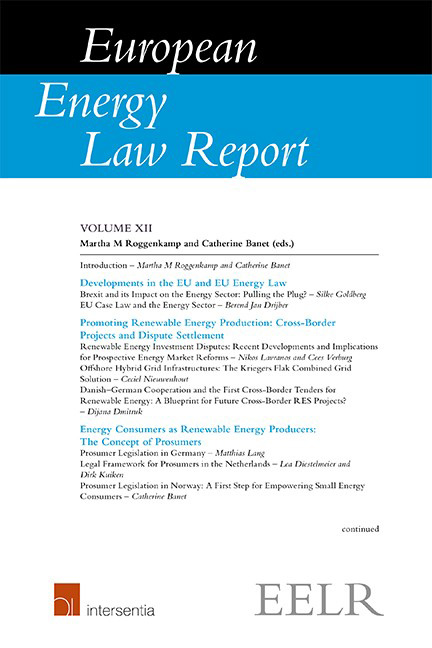Book contents
- Frontmatter
- Preface
- Contents
- List of Abbreviations
- List of Contributors
- Introduction
- PART I Developments In The EU and EU Energy Law
- PART II Promoting Renewable Energy Production: Cross-Border Projects And Dispute Settlement
- PART III Energy Consumers As Renewable Energy Producers: The Concept Of Prosumers
- PART IV Balancing Renewable Electricity Production Withsupply Security: National Experiences With Capacity Mechanisms
- Chapter IX The Capacity Market in Great Britain
- Chapter X Capacity Mechanisms in Germany
- Chapter XI The French Capacity Mechanism
- PART V Promoting The Use Of Sustainable Gas And Security Of Gas Supply
Chapter IX - The Capacity Market in Great Britain
from PART IV - Balancing Renewable Electricity Production Withsupply Security: National Experiences With Capacity Mechanisms
Published online by Cambridge University Press: 31 January 2019
- Frontmatter
- Preface
- Contents
- List of Abbreviations
- List of Contributors
- Introduction
- PART I Developments In The EU and EU Energy Law
- PART II Promoting Renewable Energy Production: Cross-Border Projects And Dispute Settlement
- PART III Energy Consumers As Renewable Energy Producers: The Concept Of Prosumers
- PART IV Balancing Renewable Electricity Production Withsupply Security: National Experiences With Capacity Mechanisms
- Chapter IX The Capacity Market in Great Britain
- Chapter X Capacity Mechanisms in Germany
- Chapter XI The French Capacity Mechanism
- PART V Promoting The Use Of Sustainable Gas And Security Of Gas Supply
Summary
INTRODUCTION
This chapter outlines the Capacity Market (CM) which exists in Great Britain (GB). It covers some of the context and history of the mechanism including how the CM was designed, the process required for State aid approval and the legislation that underpins it. It then briefly refers to the economic theory behind capacity mechanisms and reviews how the CM in GB works in practice. Finally, it analyses the results seen so far in GB and some of the future challenges as the energy market continues to evolve.
CONTEXT AND HISTORY
CHANGES TO THE ENERGY SYSTEM
Great Britain, like many countries in Europe, is facing significant changes in its electricity system. Many traditional generators, such as large coal and nuclear plants, are coming to the natural end of their lives. This is not only a recent phenomenon: 11.5 GW of coal and oil capacity closed before 2015 due to the implementation of the EU Large Combustion Plant Directive. At least a further 8 GW of capacity is expected to close by 2030 as they become uneconomic, leading to a greater need for investment in replacement capacity. In addition, the power sector must make significant reductions in its carbon intensity in order to meet legally binding emissions targets. The Government's most recent Carbon Budget set a target for 2030 for reducing carbon emissions by 57 % compared to 1990 levels.
Intermittent generating technologies such as solar and wind are an increasingly significant part of the electricity system with almost 30GW installed by the end of 2017. Renewable sources provided almost a quarter of total UK electricity generation in 2016 compared to only 5 % in 2006. This creates an increasing need for flexibility and for backup generation to cover periods where intermittent technologies are not delivering.
The way the system is being used is also changing. New technologies such as electricity storage are being deployed on a commercial scale as costs reduce. And more generators are now locating closer to customers and connecting directly to the distribution system. All of these changes are creating new challenges for the market, system operators, regulators and government.
- Type
- Chapter
- Information
- European Energy Law Report XII , pp. 193 - 208Publisher: IntersentiaPrint publication year: 2018

